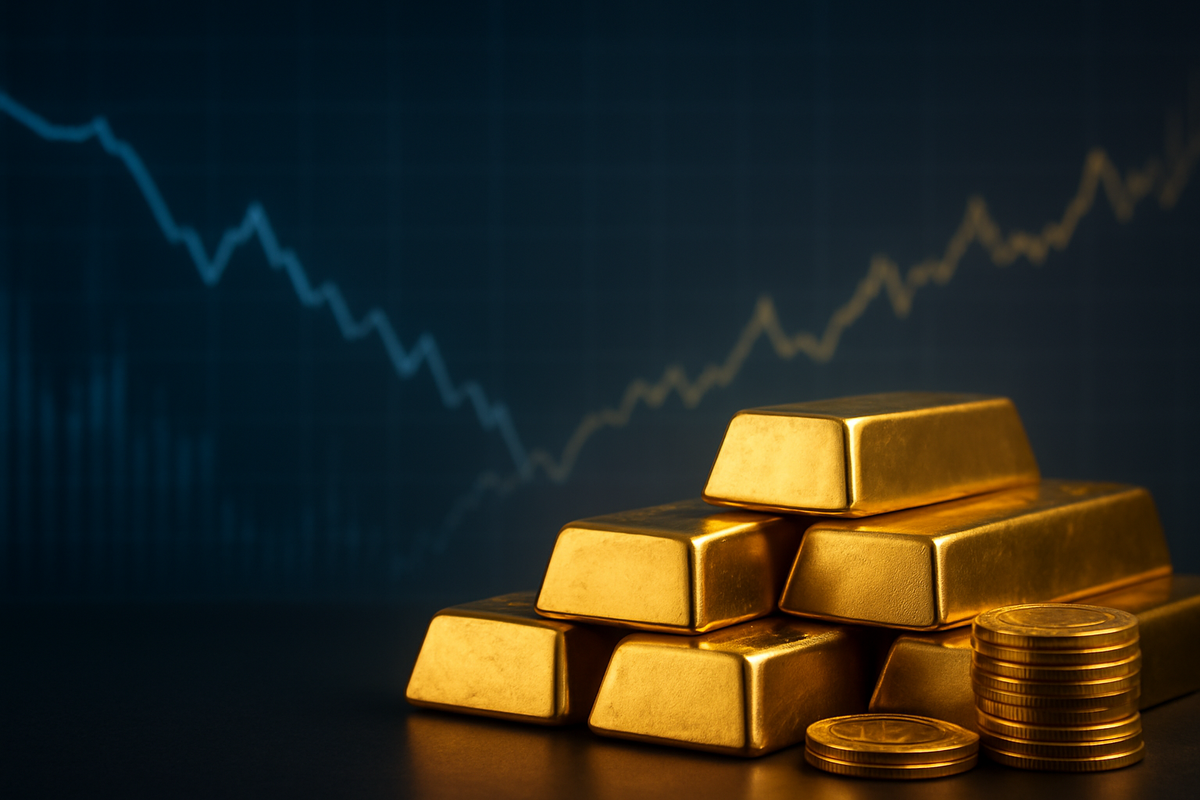
The golden sheen of stability has recently dulled for investors, as gold futures have experienced a notable downturn, prompting a re-evaluation of its trajectory for the final months of 2025. This immediate correction, following a period of significant gains, has introduced a fresh layer of uncertainty into the market. As the calendar turns towards November and December, traditionally periods of increased seasonal demand, market participants are keenly observing global economic shifts, central bank policies, and geopolitical developments that are poised to dictate the precious metal's immediate future. The recent dip, while causing some apprehension, is viewed by many as a healthy consolidation within a broader bullish trend, setting the stage for a potentially dynamic end to the year.
Federal Reserve's "Hawkish Cut" Triggers Gold's Retreat
The recent decline in gold futures, particularly for November and December 2025 contracts, can be largely attributed to a pivotal policy decision by the United States Federal Reserve. In what analysts have dubbed a "hawkish cut," the Fed delivered a 25-basis-point rate reduction but simultaneously tempered expectations for further easing. Federal Reserve Chair Jerome Powell's comments, downplaying the likelihood of another rate cut in December due to internal policy divisions, sent ripples through the market, leading to profit-taking and a retreat from safe-haven assets. This unexpected caution from the Fed created an environment less conducive to gold, which typically thrives in periods of aggressive monetary easing.
Adding to the downward pressure was a renewed wave of optimism surrounding US-China trade relations. Hints of progress in talks between President Donald Trump and President Xi Jinping served to diminish the perceived need for gold as a safe haven. Consequently, gold prices tumbled from above US$4,000 to near US$3,900, marking a three-week low before a modest recovery during the Asian trading session. From a technical standpoint, the market had shown signs of being overbought, with the weekly Relative Strength Index (RSI) hitting a record 92, indicating that a correction of approximately 5.8% from its peak was a natural market adjustment.
The timeline leading up to this moment saw gold reaching record highs, fueled by persistent inflation concerns, geopolitical tensions, and robust central bank demand. However, the confluence of the Fed's nuanced policy stance and positive trade news provided the catalysts for the recent pullback. Key players involved include the Federal Reserve, whose policy pronouncements are always closely scrutinized, and the US and Chinese governments, whose trade negotiations directly impact global risk sentiment. Initial market reactions saw a swift sell-off in gold futures, though spot gold showed some resilience, initially moving higher against a sliding U.S. Dollar, highlighting the complex interplay of various market forces.
Corporate Fortunes Tied to Gold's Glitter
The ebb and flow of gold prices have a direct and often amplified impact on the fortunes of public companies operating within the precious metals sector. Gold mining companies, in particular, exhibit a leveraged relationship with the price of the metal, meaning their profitability can surge or plummet disproportionately to gold's movements due to their significant fixed operating costs.
Major global gold producers stand to gain substantially from a rising gold price. Companies like Newmont (NYSE: NEM), the world's largest gold miner, and Barrick Gold (NYSE: GOLD), another Canadian-headquartered industry giant, benefit immensely as higher gold prices translate into increased revenues against relatively stable production costs. This operating leverage can lead to a magnified increase in profit margins, cash flows, and ultimately, their stock valuations. Other significant players such as Agnico Eagle Mines (NYSE: AEM), Kinross Gold (NYSE: KGC), Gold Fields (NYSE: GFI), and Alamos Gold (NYSE: AGI) also see their financial health directly tied to the precious metal's market performance. Even companies like Freeport-McMoRan (NYSE: FCX), while primarily a copper producer, benefit from their substantial gold output, especially from mines like Grasberg.
Conversely, a sustained downturn in gold prices can severely challenge these same companies. Those with higher "All-in Sustaining Costs" (AISC) – the comprehensive cost of producing an ounce of gold – will see their profit margins quickly erode, potentially leading to operational losses or even the closure of less efficient mines. Companies with significant debt levels are particularly vulnerable, as falling revenues can strain their ability to service obligations.
Beyond miners, Precious Metal Exchange Traded Funds (ETFs) offer a more direct, albeit expense-adjusted, exposure to gold's price movements. ETFs like SPDR Gold Shares (GLD), the largest gold ETF globally, along with iShares Gold Trust Micro ETF (IAUM), SPDR Gold MiniShares Trust (GLDM), and abrdn Physical Gold Shares ETF (SGOL), track the spot price of physical gold. Their share prices directly reflect the value of the underlying bullion they hold. When gold prices rise, these ETFs see their Net Asset Value (NAV) and share price increase, making them "winners." Conversely, a fall in gold prices directly translates to a decline in their value, making them "losers." Similarly, ETFs tracking other precious metals, such as iShares Silver Trust (SLV) for silver, abrdn Standard Physical Platinum Shares ETF (PPLT) for platinum, and abrdn Standard Physical Palladium Shares ETF (PALL) for palladium, mirror the performance of their respective metals. The abrdn Standard Physical Precious Metals Basket Shares ETF (GLTR), which holds a diversified mix of physical gold, silver, platinum, and palladium, would see its performance influenced by the weighted average movements of these metals.
Gold's Enduring Role in a Shifting Global Landscape
The recent movements in gold prices, while significant, fit into a broader narrative of the metal's enduring role as a safe-haven asset and a hedge against economic instability. This event underscores several wider industry trends and potential ripple effects. Firstly, the actions of central banks, particularly the U.S. Federal Reserve, remain paramount. While a "hawkish cut" can induce short-term volatility, the overarching trend of global central bank policies—often leaning towards looser monetary conditions or diversifying reserves away from traditional currencies—continues to provide a strong structural tailwind for gold. Emerging market central banks, in particular, have been consistent buyers, a trend expected to continue with average purchases projected around 900 tonnes in 2025.
The strength or weakness of the U.S. Dollar also plays a critical role. A weaker dollar makes gold, priced in the greenback, more attractive to international buyers, thereby boosting demand. Conversely, a strengthening dollar, often driven by higher interest rate expectations, can exert downward pressure. Geopolitical developments, ranging from ongoing trade disputes between major economic powers to regional conflicts and political uncertainties, consistently bolster gold's appeal as a store of value when global stability is perceived to be at risk. Any escalation or de-escalation of these tensions can trigger immediate shifts in investor sentiment towards gold.
Historically, gold has demonstrated its resilience during periods of economic uncertainty, acting as a hedge against inflation and a safe haven during recessions or slowing growth. This event is not an isolated incident but rather a continuation of gold's traditional function, albeit with contemporary influences. The regulatory environment, while not directly impacted by this specific price movement, remains a background factor. Any significant policy changes related to commodity markets, trade, or international finance could indirectly influence gold's attractiveness. This recent correction can be compared to similar instances in the past where gold experienced pullbacks after significant rallies, often due to shifts in monetary policy expectations or temporary improvements in global risk sentiment, only to resume its upward trajectory as underlying uncertainties persisted.
Navigating the Golden Path Ahead: Opportunities and Challenges
Looking ahead to November and December 2025, the gold market is poised for continued dynamism, presenting both opportunities and challenges for investors. In the short term, the market will be highly sensitive to further communications from the Federal Reserve regarding future interest rate policy. Any hints of a more dovish stance, especially if economic data suggests a slowdown or increased recession probabilities, could trigger a swift rebound in gold prices. Conversely, a stronger-than-expected economic performance in the U.S. or a more aggressive stance from the Fed could extend the current period of consolidation or even lead to further declines.
Beyond monetary policy, the evolution of US-China trade relations will be a critical determinant. A definitive trade deal could temporarily reduce safe-haven demand, while any renewed tensions or stalled negotiations would likely send investors back to gold. Seasonally, November and December typically witness increased physical demand for gold due to holiday gift-giving and cultural festivals, particularly in major consuming nations like India and China. This seasonal uptick could provide underlying support for prices, potentially initiating a "Santa Rally" for the precious metal.
Long-term possibilities remain largely bullish, according to many analysts. J.P. Morgan Research, for instance, projects gold to average $3,675/oz by Q4 2025 and climb towards $4,000/oz by Q2 2026, citing a "structural bull case" driven by persistent recession probabilities, trade risks, and robust demand from central banks and institutional investors. Market opportunities may emerge for investors looking to buy on dips, particularly if technical support levels around $3,970 or $3,900 hold firm. Challenges include the potential for a stronger U.S. Dollar, which could dampen gold's appeal, and unforeseen positive global economic developments that reduce overall market uncertainty. Potential scenarios range from a continued consolidation phase followed by a year-end rally, to a more pronounced correction if global risks abate significantly, though the latter appears less likely given the prevailing macroeconomic and geopolitical landscape.
Gold's Resilient Outlook: A Strategic Asset for Uncertain Times
In summary, the recent downturn in gold futures, while a notable event, appears to be a technical correction within a broader uptrend, influenced primarily by the Federal Reserve's "hawkish cut" and renewed optimism in US-China trade talks. This period of adjustment has highlighted gold's sensitivity to monetary policy expectations and global risk sentiment. Public companies such as major gold miners like Newmont (NYSE: NEM) and Barrick Gold (NYSE: GOLD), along with prominent precious metal ETFs like SPDR Gold Shares (GLD), are directly impacted, experiencing amplified gains during price rallies and magnified losses during downturns.
Moving forward, the market will remain acutely focused on central bank guidance, particularly from the Fed, and the trajectory of geopolitical and trade relations. The underlying fundamental investment case for gold, underpinned by concerns over currency debasement, inflation hedging, and its role as a safe haven during periods of economic and political uncertainty, continues to provide strong support. While short-term volatility is to be expected, the prevailing sentiment among many financial institutions remains bullish for the final quarter of 2025 and into 2026.
Investors should watch for key indicators such as inflation data, U.S. Dollar strength, and any shifts in central bank rhetoric. Geopolitical developments, especially those related to trade or international conflicts, will also be crucial. The seasonal demand patterns in November and December could provide additional upward momentum. Ultimately, gold continues to assert its significance as a strategic asset, offering portfolio diversification and wealth preservation capabilities in an increasingly complex and uncertain global financial environment.
This content is intended for informational purposes only and is not financial advice






